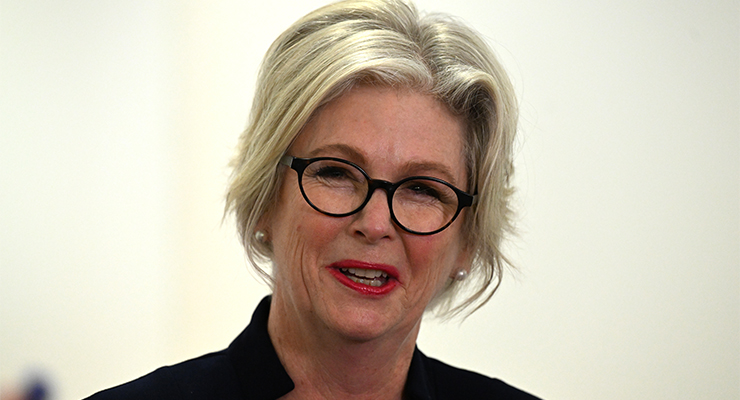
Independent Helen Haines has been appointed deputy chair of the Joint Committee on National Anti-Corruption Commission (NACC) Legislation — a position she has been vying for since discussions began.
Having an independent deputy chair of such a high-profile committee is rare. Generally, an MP from the government in power takes the chair, while a member of the opposition takes up the deputy role. Joint committee chairs are elected (in contrast to house committee chairs, who are appointed by the prime minister). But given Labor MPs will make up the majority of members, electing someone from outside the party is uncommon.
The current 47th Parliament is diverse — across both houses, Labor politicians make up 45.3% of MPs, the Coalition makes up 39.6%, and those from the Greens, minor parties and independents make up 14.9%. The House of Representatives has the strongest crossbench in history, with 16 members — four Greens MPs, 10 independents and two minor parties.
Yet independents, Greens and minor party MPs rarely hold top committee spots. Currently, there are 16 house committees, 25 Senate committees (taking into account legislative and references committees) and 22 joint committees. Just four committees are chaired or deputy chaired by minor parties — the Greens chair three committees in the Senate, and Haines is the only independent to hold a chair or deputy chair role. While Parliament is 45.3% Labor, it makes up 51% of all committee representation.
Across house committees, Labor MPs make up 58% of members (but just 51% of upper house MPs), followed by 34% Coalition, 5.5% independents, 1.3% minor parties and 0.68% Greens. All committee chairs are Labor MPs and all deputy chairs are Coalition members, with the exception of two committees that haven’t appointed deputy chairs (one of which also hasn’t appointed a chair).
It’s a similar story in the Senate — while independent and minor party members (excluding the Greens) make up nearly 8% of senators, they make up just 2.3% of Senate committee members. Across joint committees, they make up just 3.9% of members despite making up 7.9% of Parliament.
Haines told Crikey she was honoured to have gained the spot. “It is significant that a senior member of this committee comes from outside the major parties and it will contribute to the multi-partisanship that I hope will support the NACC,” she said.
But she added that the committee structure hasn’t moved with the changes in Parliament.
“The same structures and the same conventions are being held pretty tightly and the government and opposition are really hanging tight to opportunities to have majority numbers in committees and be chair or co-chair.”
She said that while Prime Minister Anthony Albanese spoke about creating a more collaborative environment, collaboration and representation needed to extend to the committee structure.
Greens Senator Jordon Steele-John is the only Australian politician with a visible disability. Despite his advocacy for improving the National Disability Insurance Scheme (NDIS), he is only a member on the joint standing committee — not a chair or co-chair.
He told Crikey it was high time Parliament reviewed the make-up of committees.
“Committees have incredible potential to provide oversight and scrutiny of legislation and government actions. This potential is continually undermined by the major parties colluding to control committees, limit the scope of investigations, ignoring key evidence in recommendations and handing out chair positions as political prizes,” he said.
More representation, he argued, would lead to a more robust debate with a greater diversity of views.
“Labor and Liberal-controlled committees are often under pressure to toe the party line, which can lead to committees not fully exploring issues raised, leading to less fulsome and transformative recommendations being made.”
He believes that the NDIS committee should be chaired by a non-government member who represented the disability community.
Labor’s Linda White will chair the NACC legislation committee with ALP members including Tania Lawrence, Catryna Bilyk, Glenn Sterle, Sam Lim and Tony Zappia. Members also include Claire Chandler, Llew O’Brien, Paul Scarr and Keith Wolahan from the Coalition and the Greens’ David Shoebridge. That’s six Labor, four opposition and two minor parties (participating members also include 13 senators).
The committee will report on the provisions of two NACC bills. Submissions are open until next Friday.








Would have preferred to see her as Chair but politics will be politics.
Haines is the classiest member in the House – thank-you Indi. Compare Haines’ appointment to Hanson’s appointment to deputy chair of the family law inquiry. What a difference an election makes – woo hoo! 🙂
The LNP can only offer chicanery and disruption. They should not be appointed to any Chair or Deputy Chair.
Great choice and wish her well.
It is pleasing that an Independent – Helen Haines has been elected to be Deputy Chair.
And her first act is to complain about the structure of the Committee, obviously wanting more Independents.
But I think her Maths is a bit out, as it looks pretty balanced to me:
The ALP has 6 Members on the committee, or 50% – Whilst having 45% of Parliamentarians
Coalition has 4 Members on the committee, or 33% – Whilst having 40% of Parliamentarians
Independents have 2 Members on the committee, or 17% – Whilst having 15% of Parliamentarians
I’m amazed Amber isn’t complaining that there aren’t enough women on the committee.
At least a ‘baker’s dozen’ – never mind that there are only 12 chairs.